Zinedine Zidane’s Real Madrid side host Italian giants Inter this week in the UEFA Champions League group stages. Both teams have struggled in their groups, with Madrid picking up only one point, and Inter only two points. This match will be an extremely interesting tactical battle between both sides, who have similar deficiencies and strengths in their teams.
Antonio Conte’s side are currently sitting in fifth in Serie A, however, the number of goals that his side have conceded since the start of the season will be seriously worrying for him coming up against a very potent Real Madrid forward line. They have conceded 12 goals already since the beginning of the campaign in all competitions.
Real Madrid have not covered themselves in glory either with their defensive record this season, having conceded 10 goals despite sitting top of the league once more. Both sides need to start picking up points, and a win in this game for either will be absolutely crucial to the outcome of the group standings come December.
This tactical analysis article will be an analysis of the tactics that both sides will look to use against one another in the upcoming tie. We will be analysing how each team will set up offensively as well as defensively, and how they can exploit each other’s weaknesses.
Lineups and formations
It is quite uncertain as of yet exactly what starting lineup each manager is going to put out for this matchup. The starting teams for each side have fluctuated and have been rotated constantly due to the flurry of games in quick succession ever since the 2020/21 season began.
For Inter, they will of course use a back three formation. Conte generally switches between a 3-4-1-2 and a 3-5-2 depending on the opposition. Generally, the 3-5-2 is utilised by the Italian giants against tougher opponents so one would expect this to be the choice of formation ahead of this crucial Champions League tie.
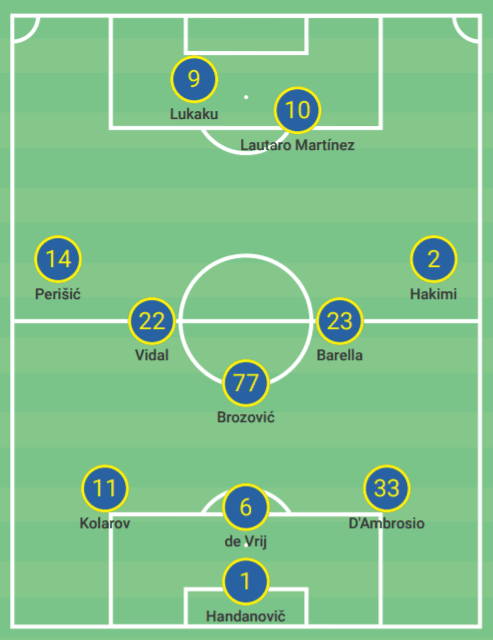
In the previous Champions League game against Shakhtar Donetsk, in which the game finished 0-0, this was the starting lineup for Inter, with Ashley Young at left wing-back, and Alessandro Bastoni being the only exceptions.
This is arguably their strongest starting eleven with two make-shift centre-backs flanking the central centre-back Stefan de Vrij. In the past two Serie A games, Andrea Ranocchia played at the back instead of Danilo D’Ambrosio, so this is also another option for the Italian manager.
Brozovic sits as the single pivot in midfield with Nicolo Barella and Arturo Vidal deployed as the advanced central midfielders with Young and Hakimi out on the flanks, keeping the width. Ivan Perisic is also an option at wing-back due to his excellent offensive and defensive capabilities.
Finally, Romelu Lukaku and Lautaro Martinez will more than likely partner up front together, however it is also quite possible that Alexis Sanchez starts instead of the Argentine.
With regards, to Real Madrid, this is arguably their strongest team to go face-to-face with Inter on Tuesday night.
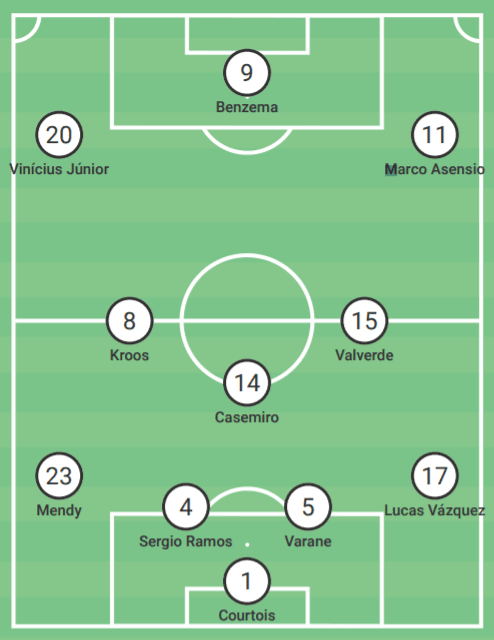
The two centre-backs and goalkeeper are almost certainly nailed on, but with respect to the full-backs, there are a few different options that the French coach can choose from. Marcelo started in Real Madrid’s previous league win against Huesca, but some may feel that Ferland Mendy has surpassed the Brazilian in this side.
Lucas Vasquez also started their last two games but is clearly not comfortable playing at right-back. Inter will almost certainly target the Spaniard as the main weakness in Madrid’s defence, so Zidane may use Eder Militao there instead as he can also play at right-back.
The rest of the team will more than likely stay the same, with the exception being on the left wing where Hazard is now back and is fit to play instead of Vinicius Junior who has struggled in recent matches.
Real Madrid’s unique build-up play
Ever since Zinedine Zidane took over Los Blancos the second time, he has tried to rejuvenate the Spanish club’s style of play from his first spell in charge. He has turned them into a side focused on retaining the ball, which includes in their build-up play.
Real’s build-up play had gotten quite stale and predictable, so Zidane set out, particularly during the 2019/20 season, to make their build-up play more effective and unpredictable. He did this using Toni Kroos.
Whilst in-possession, Kroos is by far Real Madrid’s most important player as he sets the tempo, direction, and range of their build-up play. In the first phase of the attack, Real like to have five players including the goalkeeper in front of the opposition’s first line of press.
Kroos drops in as an auxiliary left-back whilst Mendy moves into central midfield as an inverted full-back, as seen by Manchester City and Barcelona under Pep Guardiola.
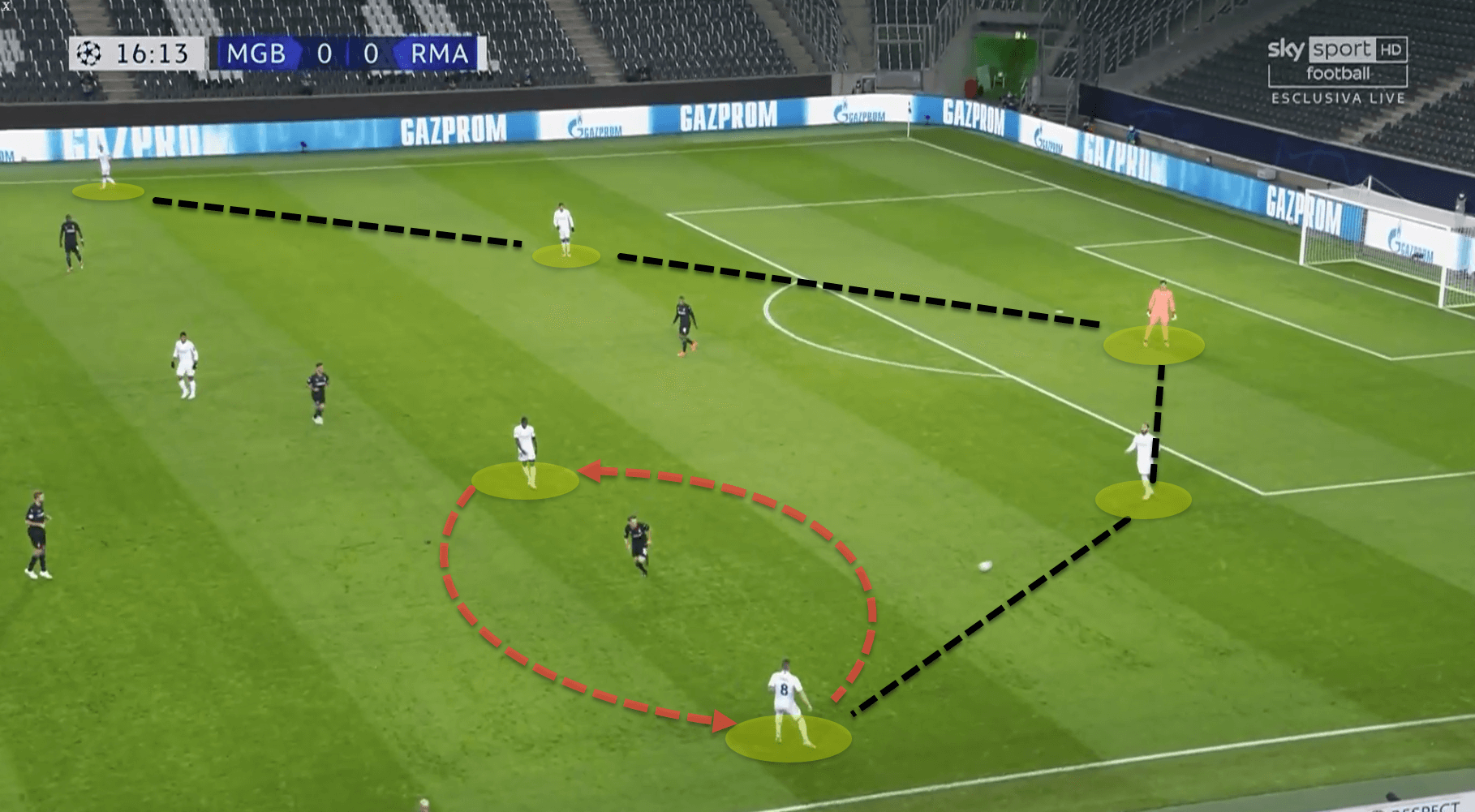
Here is an example of this exact build-up play occurring in Real Madrid’s previous Champions League game against Borussia Monchengladbach. Real’s two centre-backs in the 4-3-3 split wide, allowing the goalkeeper Thibaut Courtois to act almost as a third centre-back in possession.
From the image above, we can see that the Spanish giants maintain a back four structure, however, Kroos and Mendy interchange positions, with Kroos dropping in as a make-shift full-back whilst Mendy occupies the central corridors next to Casemiro.
Against Inter on Tuesday, this rotation during the build-up phase will be crucial. The main reason for this is because Inter like to defend by compacting the central spaces in their mid-to-high 5-3-2 defensive block.
Inter press high in a type of man-to-man pressing scheme, but the advanced central midfielders are tasked with two players out of possession.
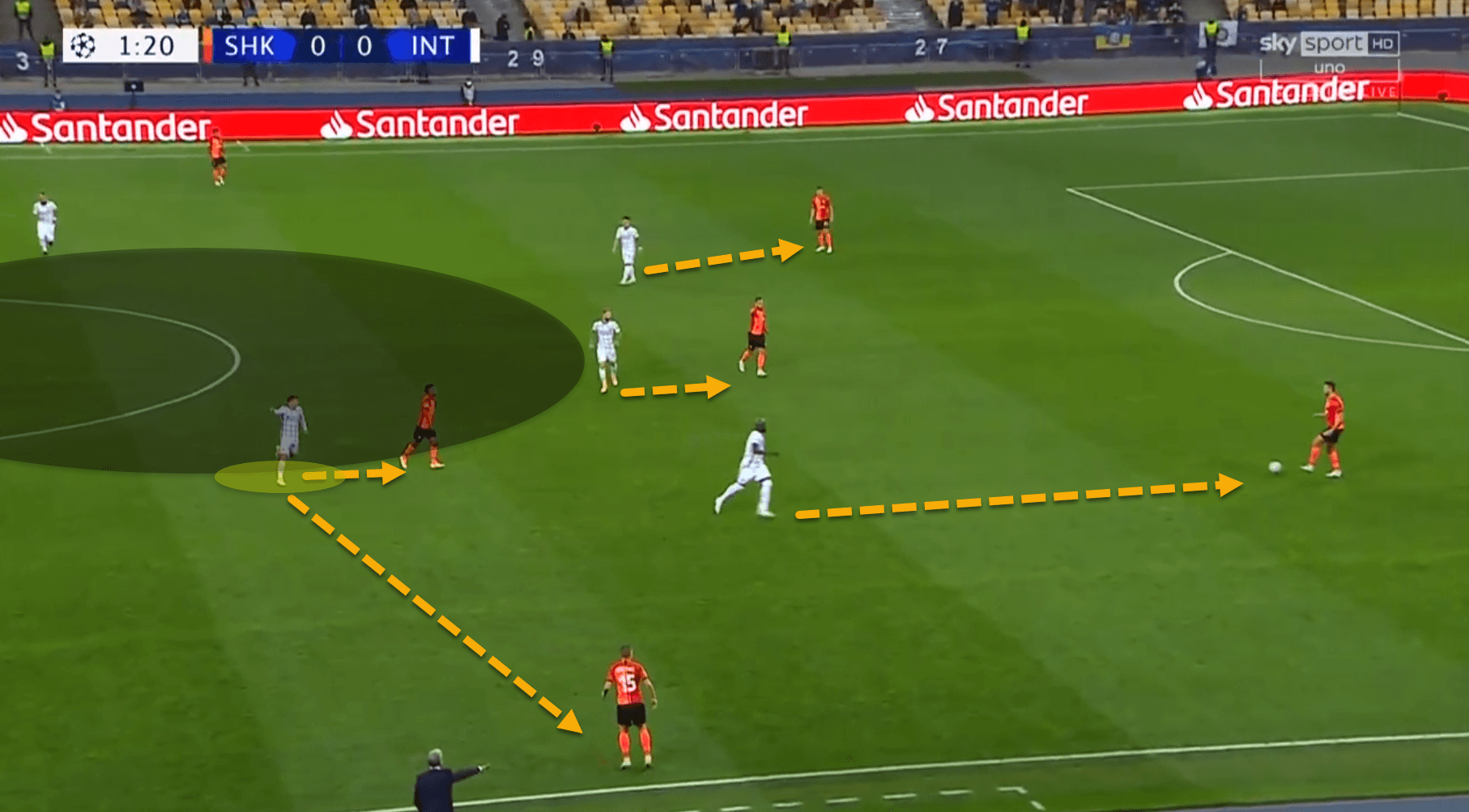
This man-oriented pressing system can be seen in the image above. Inter’s two centre-forwards are instructed to press the opposition’s centre-backs, angling their run to force the ball-carrier to play into the central areas.
Brozovic pushes up from deep to man-mark the opposing pivot player whilst the supporting central midfielders mark their opposite numbers in the press. The shape resembles a 5-2-1-2 in the press.
However, once the team in possession plays the ball out to their full-backs, the ball-near wide central midfielder for Conte’s side pushes across to press them and as can be seen in the footage from above, this leaves a lot of space in the midfield area for the opponent to play into.
Generally, the full-back will either be left-footed at left-back or right-footed at right-back and so would not be comfortable playing inside on their weaker foot. They opt instead to play down the line, but with Toni Kroos dropping into this area, as he is press-resistant, he will be able to exploit the gaps left by Inter in the midfield when the ball is played to him by quickly playing a progressive pass inside.
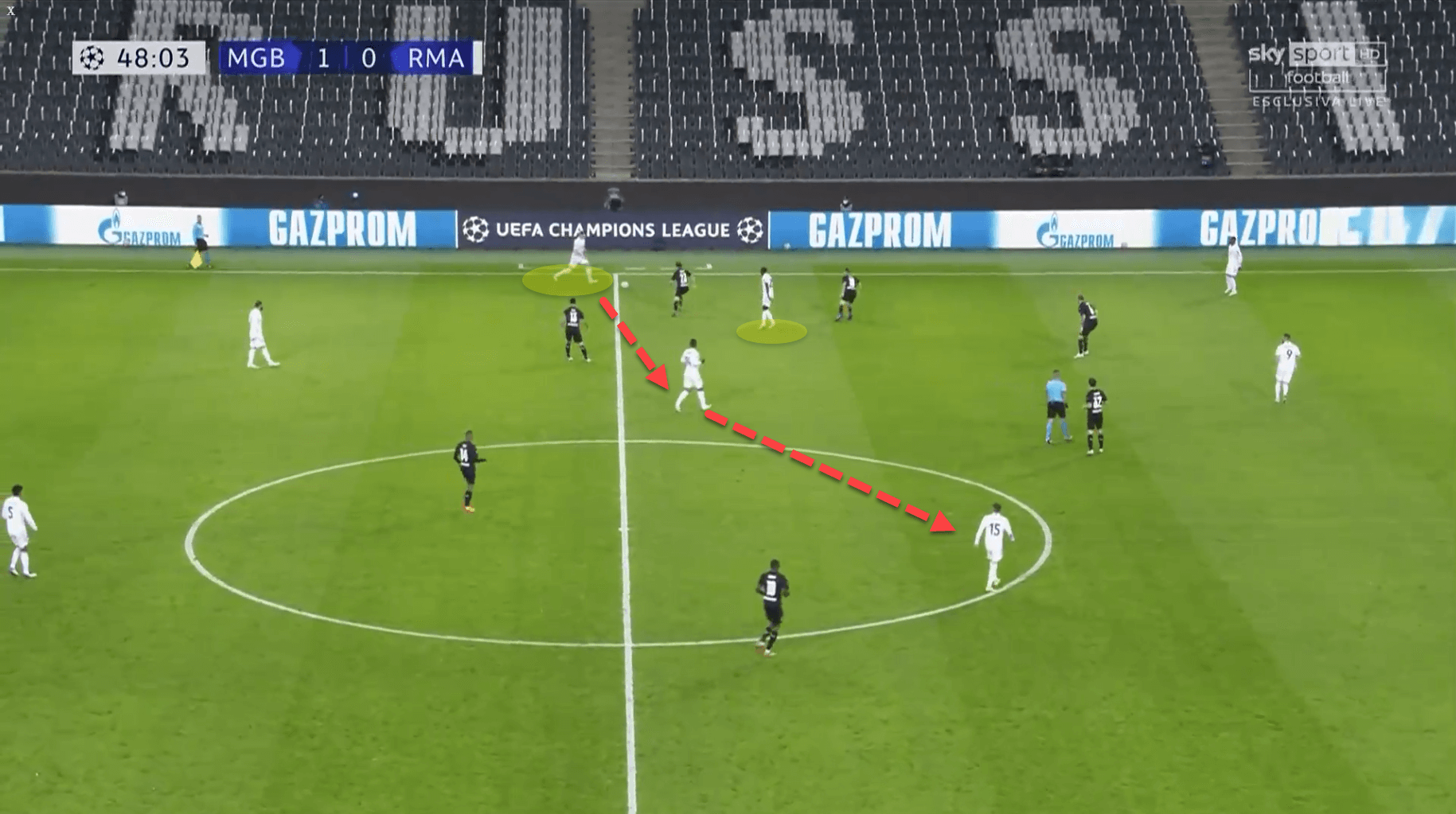
The situation above is similar to one that Real Madrid will counter in the European tie on Tuesday. Kroos is out on the left flank and has been closed down by the Monchengladbach winger. As he is right-footed, and an excellent progressive passer of the ball, the German is able to play to the inside options in plenty of space.
This will be something that Zidane’s men will try to exploit in order to get up the pitch as efficiently as possible.
Taking advantage of the offensive transitions
Both Real Madrid and Inter are very similar in terms of their weaknesses. One of the main weaknesses that both teams possess is their defensive transitions. Being weak from defensive transitions is very dangerous as teams that you play against can simply sit deep and hit you on the break with pace and precision.
The two respective sides like to play very possession-based systems and once they lose possession, their defensive transitions are predominantly focused on counterpressing with numerical superiority in order to win the ball back as high up the pitch and as quickly as possible.
This high-risk strategy for both teams can have huge benefits if it is executed successfully as the opposition’s backline will be disorientated, allowing for a quick break to create a goalscoring opportunity, much like what Liverpool do so incredibly well. However, if it fails, there can be massive implications for the defending team.
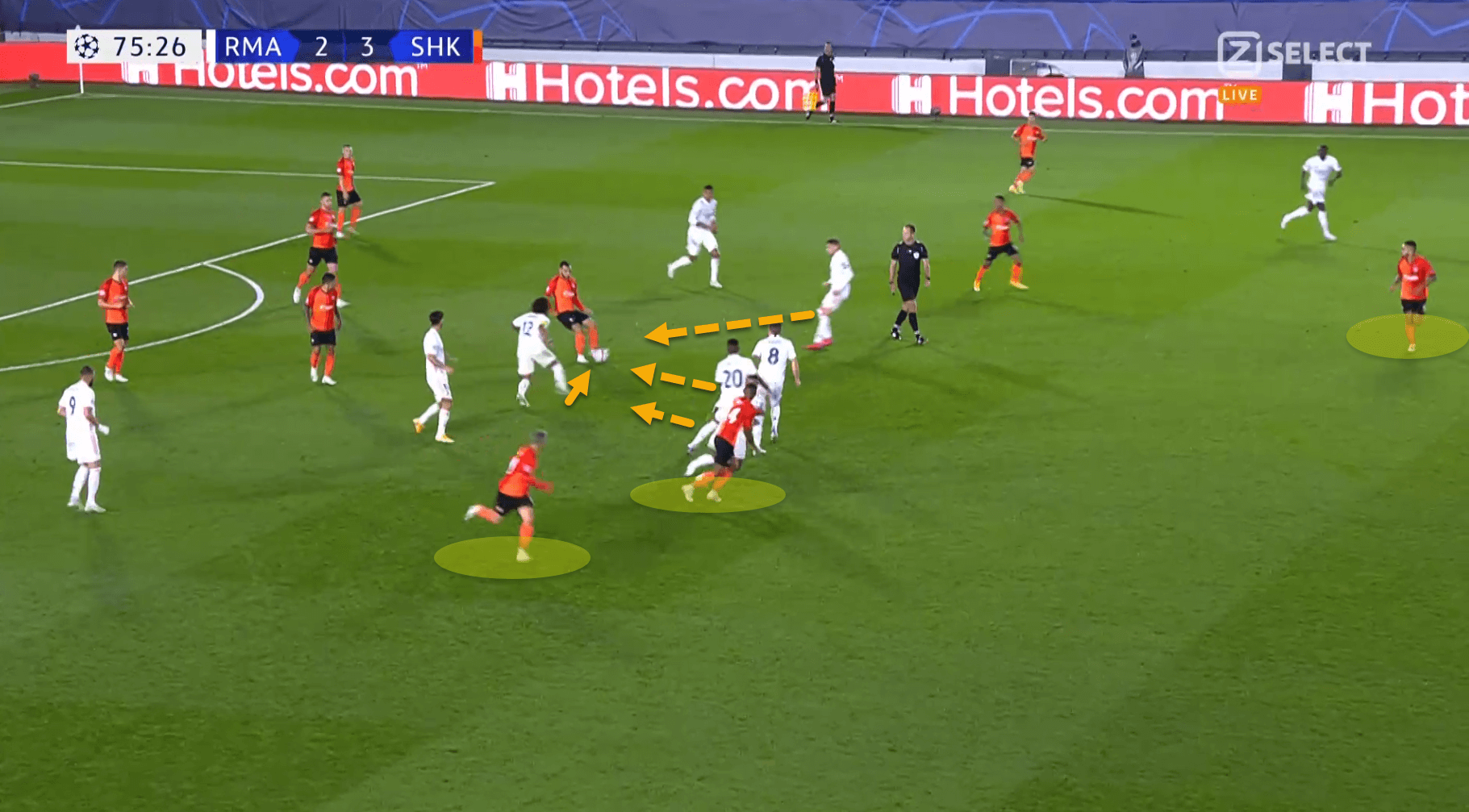
As we can see from the image above, Real have just lost the ball in the final third and counterpress the ball-carrier for Shakhtar with numerical superiority. If this works, Real will be able to transition from defence to attack and will have a great chance of creating a goalscoring opportunity.
On this occasion though, the counterpress failed. The Shakhtar player was able to get the ball out of his feet quickly and play through Los Blancos’ press, setting them away to counterattack against an exposed Real defence. Against both Shakhtar Donetsk and Monchengladbach, the opponents were ready for the counterpress and used it to their advantage with nearly all five of the goals conceded across these two matches being from their opposition’s offensive transitions.
Inter are also extremely vulnerable from these transitions for similar reasons, however, they, unlike Madrid, lack a lot of pace in their backline. The majority of the 12 goals they have conceded so far in the 2020/21 campaign in all competitions have been from counterattacks.
Naively, Conte instructs his backline to push high up the pitch whilst in possession, usually into the opponent’s half of the field. Once they lose the ball, they counterpress with two to three players at a time in order to try and regain possession, but regardless, much like with Real Madrid, if the opposition can bypass this counterpress, they will be bearing down on an exposed and slow backline that can be easily beaten.
Against their biggest rivals, Milan, in the Milan derby merely weeks ago, Stefano Pioli’s side took advantage of this with rapid transitions from defence to attack.
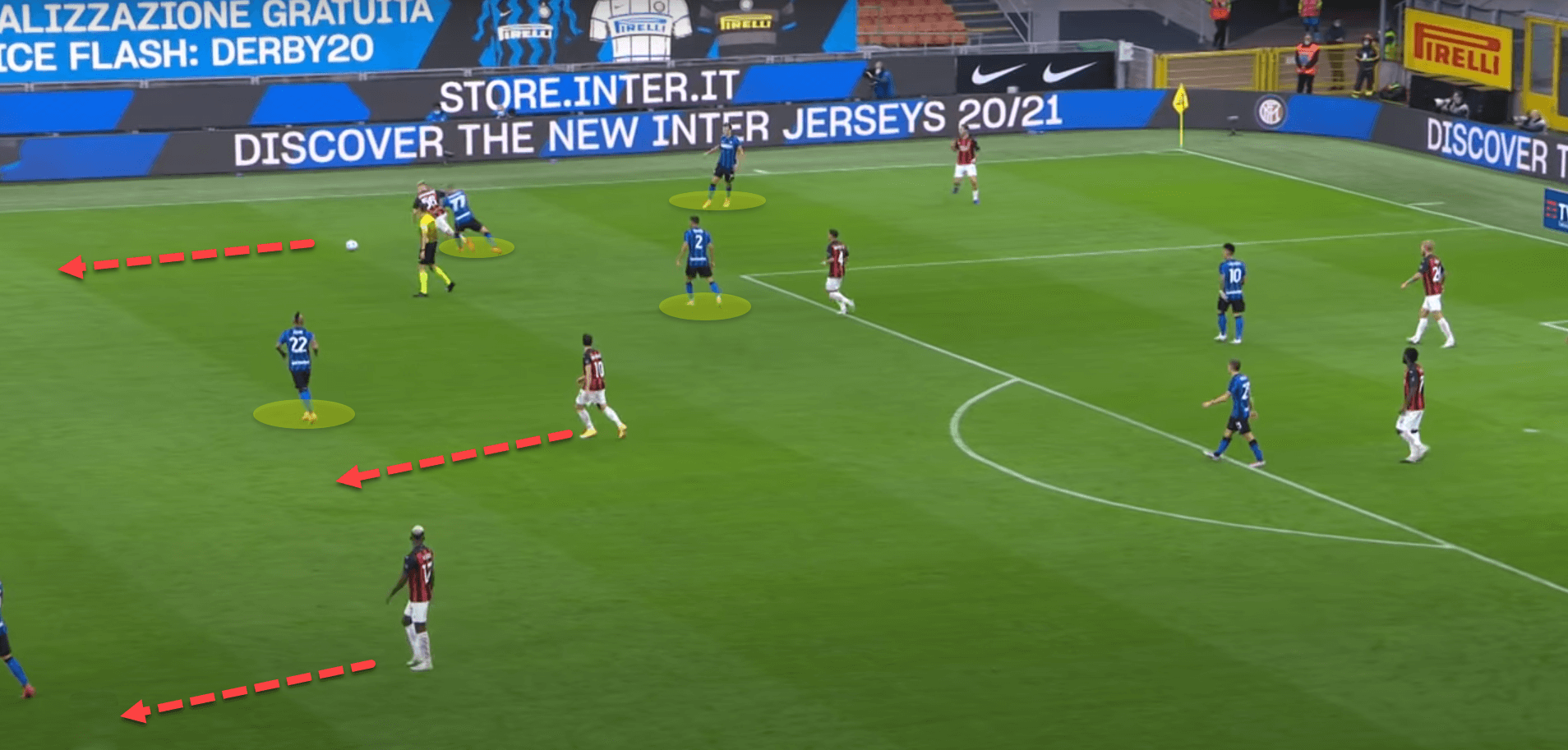
In this image, the Milan winger has completely bypassed the three-man counterpress from Inter with a quick turn of pace allowing him a free run at the backline, which they execute brilliantly leading to a goal.
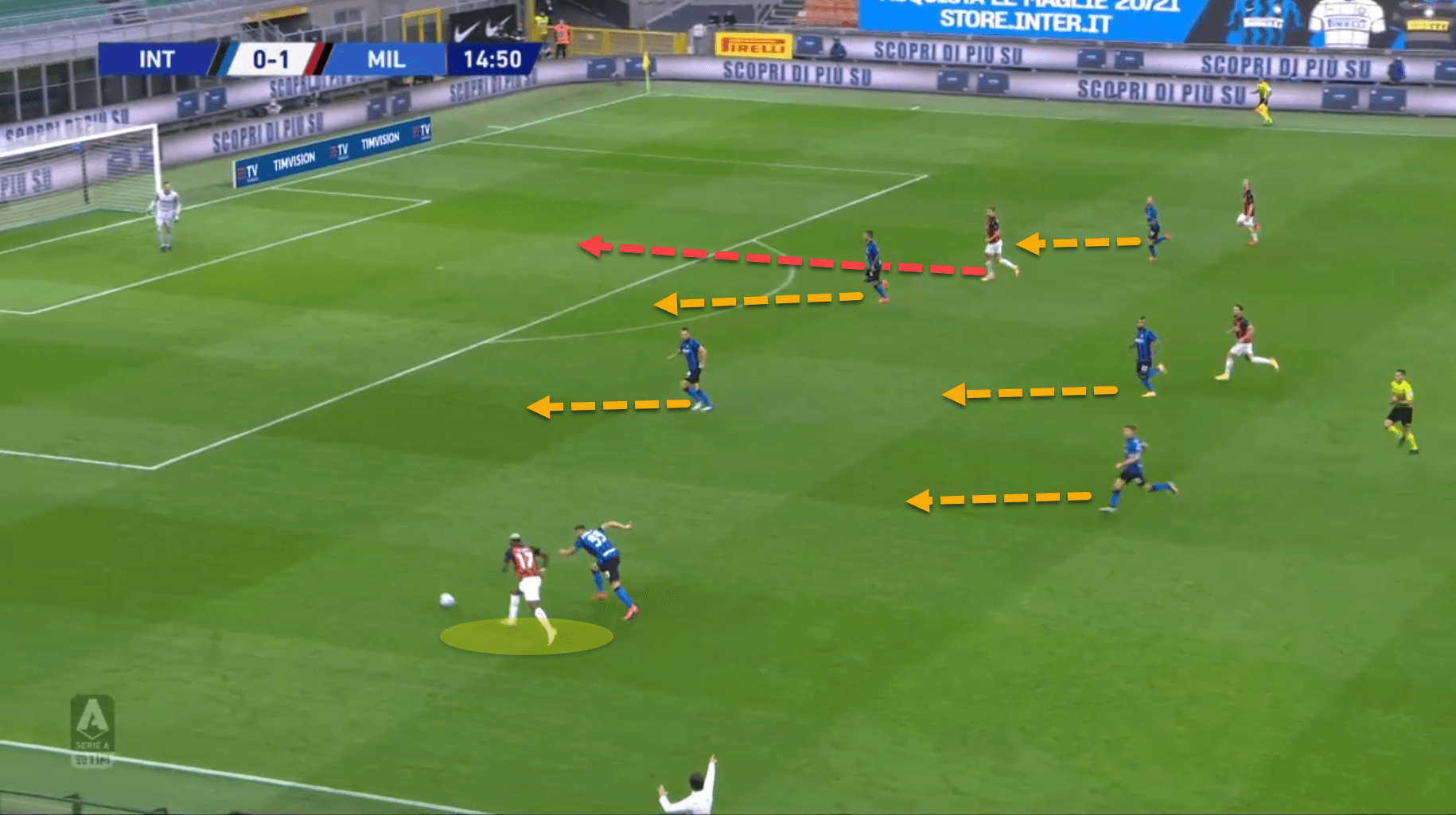
This game will be full of transitions as both teams have rapid players up front as Inter have Lukaku, Martinez, and Hakimi, whilst Real Madrid boast Vinicius Junior, Marco Asensio, etc. Whoever can execute their counterattacks more efficiently should come out on top in this match
Overlapping centre-backs
Adapting one of the newest tactical trends in football, Antonio Conte has recently started to utilise his wide centre-backs in an attacking capacity, much like Sheffield United do and like Brisbane Roar did under Robbie Fowler in the 2019/20 season. There were signs of this new tactical trend in certain matches from the previous campaign, however, it was quite sporadic.
Regardless, this season, when the opponent’s play a low-block, the wide centre-backs are given license to venture forward and create overloads in the wide areas. Against Shakhtar in the previous Champions League game for Inter, they utilised this tactic to relative success despite not scoring, as numerous chances were created on the right side from this numerical overload.
Generally, it is only the right centre-back who advances forward, as normally D’Ambrosio is used in this position, with Alessandro Bastoni and Stefan de Vrij alongside him at the back, but if Aleksandar Kolarov is also playing as a centre-back, both have license to get forward – not at the same time though.
It is expected that D’Ambrosio will play, and as he is actually a full-back, he is effective on the flanks. The trigger for this overlap is by one of the central midfielders dropping to the right of de Vrij, taking up D’Ambrosio’s space, which allows him to get forward. This can be seen in the following image.

By having an overload on this side, it not only allows Inter to have an extra man available to cross the ball, but it also forces their opponents to shift their entire defensive block over to one side so as to not be outnumbered. This in turn causes gaps to open up for their centre-forwards to get on the end of crosses to score.
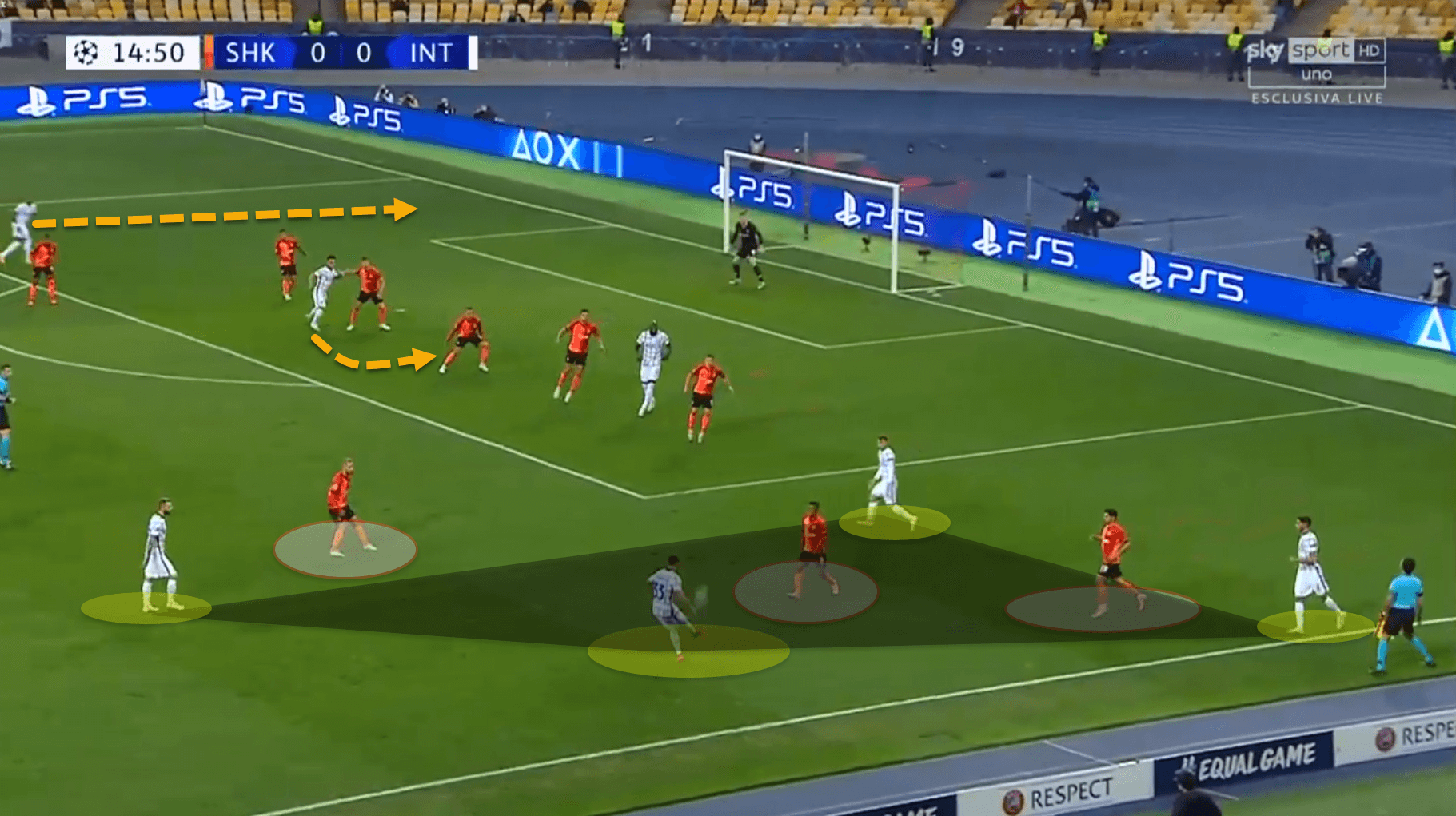
These gaps will be even more present as Real only use a back four compared to Shakhtar’s back five out of possession in a low block. If Inter can force situations like this to happen by pinning back Madrid’s defence, they will be able to create multiple dangerous situations to score from as both of their centre-forwards are proficient in the air.
Real can combat this overlap by positioning one of their forwards in between D’Ambrosio and de Vrij, forcing the Italian to stay back so as to not leave space to be exploited.
Conclusion
This game is going to be an incredibly interesting matchup tactically. On paper, one could argue that Real Madrid have a far better side and are in better form, having won their previous game 4-1 against Huesca, whilst Inter drew 2-2 to Parma. However, Antonio Conte sets his teams up brilliantly especially in the big games, so any result against Zidane’s side would be superb for I Nerazzurri.
A loss for either team would be detrimental to their hopes of qualifying for the Champions League knockout rounds, as Monchengladbach are expected to win against Shakhtar Donetsk on the same night.





Comments